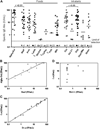Delayed anaphylaxis, angioedema, or urticaria after consumption of red meat in patients with IgE antibodies specific for galactose-alpha-1,3-galactose
- PMID: 19070355
- PMCID: PMC3324851
- DOI: 10.1016/j.jaci.2008.10.052
Delayed anaphylaxis, angioedema, or urticaria after consumption of red meat in patients with IgE antibodies specific for galactose-alpha-1,3-galactose
Abstract
Background: Carbohydrate moieties are frequently encountered in food and can elicit IgE responses, the clinical significance of which has been unclear. Recent work, however, has shown that IgE antibodies to galactose-alpha-1,3-galactose (alpha-gal), a carbohydrate commonly expressed on nonprimate mammalian proteins, are capable of eliciting serious, even fatal, reactions.
Objective: We sought to determine whether IgE antibodies to alpha-gal are present in sera from patients who report anaphylaxis or urticaria after eating beef, pork, or lamb.
Methods: Detailed histories were taken from patients presenting to the University of Virginia Allergy Clinic. Skin prick tests (SPTs), intradermal skin tests, and serum IgE antibody analysis were performed for common indoor, outdoor, and food allergens.
Results: Twenty-four patients with IgE antibodies to alpha-gal were identified. These patients described a similar history of anaphylaxis or urticaria 3 to 6 hours after the ingestion of meat and reported fewer or no episodes when following an avoidance diet. SPTs to mammalian meat produced wheals of usually less than 4 mm, whereas intradermal or fresh-food SPTs provided larger and more consistent wheal responses. CAP-RAST testing revealed specific IgE antibodies to beef, pork, lamb, cow's milk, cat, and dog but not turkey, chicken, or fish. Absorption experiments indicated that this pattern of sensitivity was explained by an IgE antibody specific for alpha-gal.
Conclusion: We report a novel and severe food allergy related to IgE antibodies to the carbohydrate epitope alpha-gal. These patients experience delayed symptoms of anaphylaxis, angioedema, or urticaria associated with eating beef, pork, or lamb.
Conflict of interest statement
Disclosure of potential conflict of interest:
The rest of the authors have declared that they have no conflict of interest.
Figures



References
-
- Kemp SF, Lockey RF, Wolf BL, Lieberman P. Anaphylaxis: a review of 266 cases. Arch Intern Med. 1995;155:1749–1754. - PubMed
-
- Yocum MW, Khan DA. Assessment of patients who have experienced anaphylaxis: a 3-year survey. Mayo Clin Proc. 1994;69:16–23. - PubMed
-
- May CD. Objective clinical and laboratory studies of immediate hypersensitivity reactions to foods in asthmatic children. J Allergy Clin Immunol. 1976;58:500–515. - PubMed
-
- Sampson HA. Food allergy. Part 1: immunopathogenesis and clinical disorders. J Allergy Clin Immunol. 1999;103:717–728. - PubMed
-
- Aalberse RC, Koshte V, Clemens JG. Immunoglobulin E antibodies that crossreact with vegetable foods, pollen, and Hymenoptera venom. J Allergy Clin Immunol. 1981;68:356–364. - PubMed
Publication types
MeSH terms
Substances
Grants and funding
LinkOut - more resources
Full Text Sources
Other Literature Sources
Medical
Molecular Biology Databases
Miscellaneous

